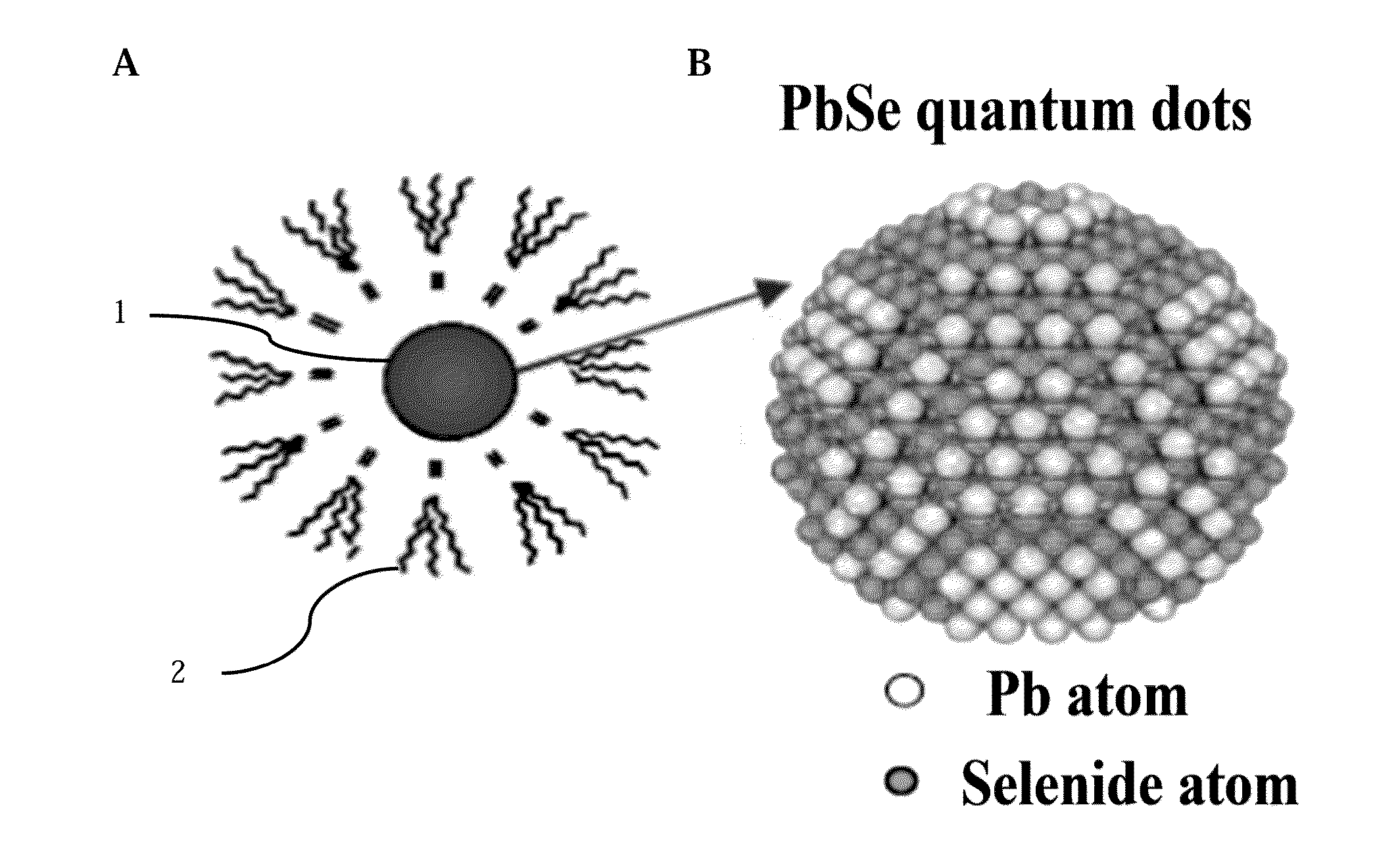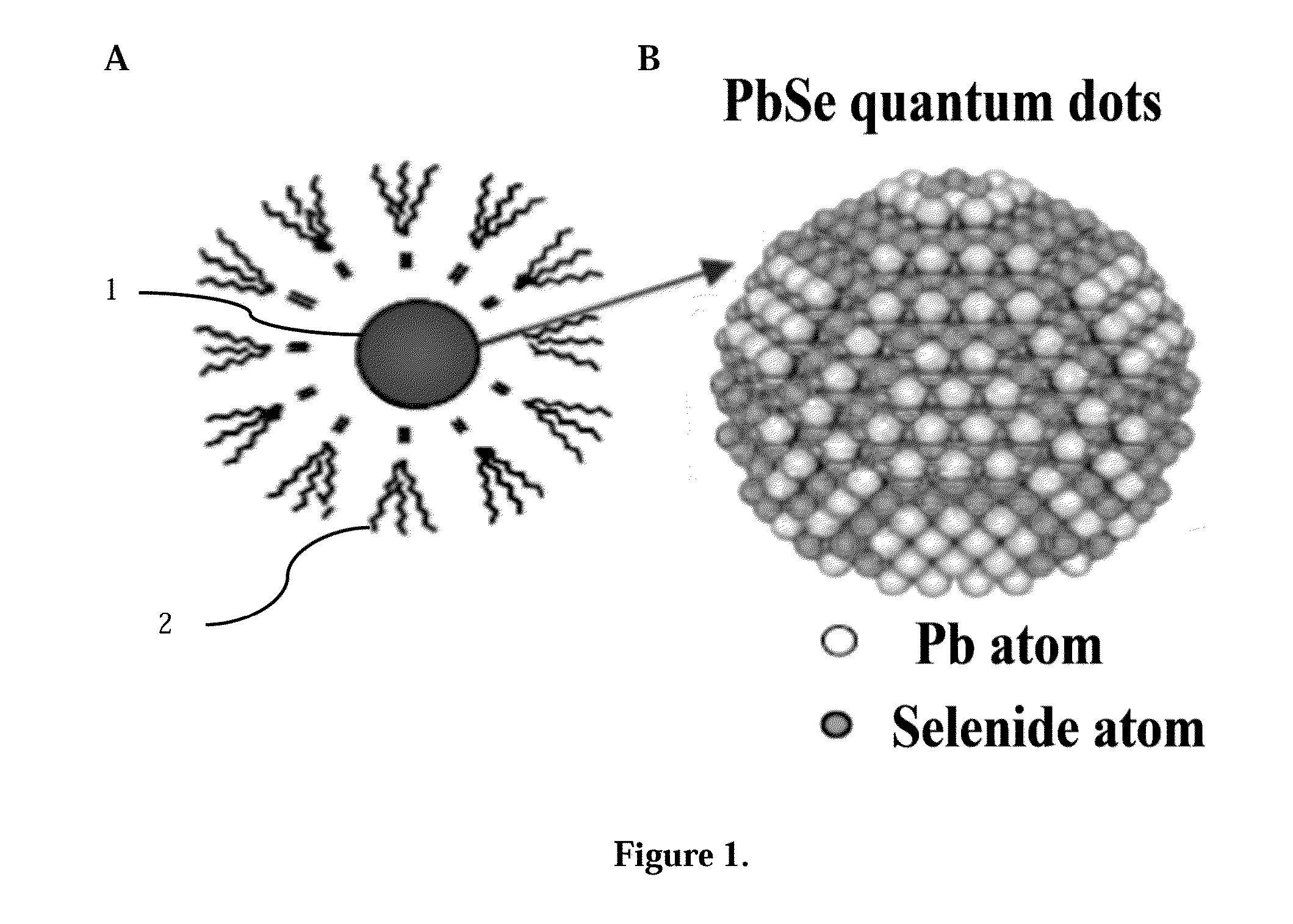Bare quantum dots superlattice photonic devices
a quantum dot and superlattice technology, applied in the field of quantum dot films, can solve the problems of missing correlation between device performance, qd superlattice properties, and methods that are bare, and achieve the effects of high luminescence efficiency, efficient exciton funneling, and high efficiency
- Summary
- Abstract
- Description
- Claims
- Application Information
AI Technical Summary
Benefits of technology
Problems solved by technology
Method used
Image
Examples
example 1
[0059]Conventional ligand washing is performed using a methanol (MeOH) washing procedure (Jiang, et al., Nanocomposite solar cells based on polymer / PbSe quantum dot. Proc. Of SPIE, 2005; 5938, 59381F). The drawback of this simple method is the lack of control over coalescence of QDs after the ligands were washed off. To address this issue, the present invention provides for a ligand washing system, as seen in FIG. 4. QDs were atomized using either a transducer or ultrasonic vibration device. Separating the QDs by atomization before entering the methanol washing apparatus prevents initial sticking of the QDs. In the illustrated version, the QD's were atomized in toluene and enter agitation device 3 through quantum dot input channel 6. However, other organic solvents, such as hexane and chloroform may be used in place of toluene. Methanol is likewise added to agitation device 3. To control the mixture of methanol to QD, the methanol flow is controlled by micro valve 4, which is electr...
example 2
[0062]A charge is provided to the bare QDs using an electrolyte (ionic solvent) with opposite charge. For positive electrolytes, non-limiting choices are poly(allylamine hydrochloride) (NH3Cl), 2-mercaptoethylamine (MEA) (Decher, Fuzzy Nanoassemblies: Toward Layered Polymeric Multicomposites, Science, 1997; 277(5330), 1232-1237; Klar, et al., Super efficient exciton funneling in LbL semiconductor structures, Adv. Materials, 2005; 17(6), 769-773), for negative ionic solvent, non-limiting choices are sodium salt of poly(styrene sulfonate) (NaSO3), thioglycolic acid (TGA).
[0063]The washed quantum dots, in methanol, are transferred from agitation device 3 to ionic solvent introduction device 15, as seen in FIG. 5. Atomized and cleaned QD's, in a methanol solvent, enter to ionic solvent introduction device 15 through quantum dot ionic input channel 16. An ionic solvent is concurrently introduced into ionic solvent introduction device 15, with the flow of the ionic solvent controlled by m...
example 3
[0065]A charge is provided to the bare QDs electrostatic variation where the final atomization stage adds a positive or negative charge to the atomized QD's.
[0066]The washed quantum dots, in methanol, are transferred from agitation device 3 to replacement ion exchange device 30, as seen in FIG. 6. Atomized and cleaned QD's, in a methanol solvent, enter replacement ion exchange device 30 through quantum dot exchange input channel 31. An exchange ion, such as a metal halide like CdCl2, (Ip, et al., Hybrid passivated colloidal quantum dot solids, Nat Nanotechnol, 2012 7, 577-582) in solvent is concurrently introduced into replacement ion exchange device 30, through micro valve 33. Flow of the exchange ion is controlled by micro valve 33, which is electrically connected to flow meter 34, thereby allowing adjustment of the exchange ion flow into exchange agitation chamber 35. The quantum dots are mixed with the exchange ion in solvent by ion exchange agitator 39 and ionic agitation vorte...
PUM
 Login to View More
Login to View More Abstract
Description
Claims
Application Information
 Login to View More
Login to View More - R&D
- Intellectual Property
- Life Sciences
- Materials
- Tech Scout
- Unparalleled Data Quality
- Higher Quality Content
- 60% Fewer Hallucinations
Browse by: Latest US Patents, China's latest patents, Technical Efficacy Thesaurus, Application Domain, Technology Topic, Popular Technical Reports.
© 2025 PatSnap. All rights reserved.Legal|Privacy policy|Modern Slavery Act Transparency Statement|Sitemap|About US| Contact US: help@patsnap.com



